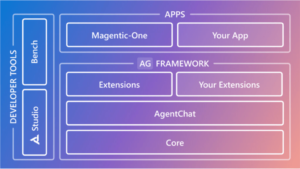
Join our daily and weekly newsletters for the latest updates and exclusive content on industry-leading AI coverage. Learn More
Microsoft Research has introduced a powerful new AI system today that generates novel materials with specific desired properties, potentially accelerating the development of better batteries, more efficient solar cells and other critical technologies.
The system, called MatterGen, represents a fundamental shift in how scientists discover new materials. Rather than screening millions of existing compounds — the traditional approach that can take years — MatterGen directly generates novel materials based on desired characteristics, similar to how AI image generators create pictures from text descriptions.
“Generative models provide a new paradigm for materials design by directly generating entirely novel materials given desired property constraints,” said Tian Xie, principal research manager at Microsoft Research and lead author of the study published today in Nature. “This represents a major advancement towards creating a universal generative model for materials design.”
How Microsoft’s AI engine works differently than traditional methods
MatterGen uses a specialized type of AI called a diffusion model — similar to those behind image generators like DALL-E — but adapted to work with three-dimensional crystal structures. It gradually refines random arrangements of atoms into stable, useful materials that meet specified criteria.
The results surpass previous approaches. According to the research paper, materials produced by MatterGen are “more than twice as likely to be novel and stable, and more than 15 times closer to the local energy minimum” compared to previous AI approaches. This means the generated materials are both more likely to be useful and physically possible to create.
In one striking demonstration, the team collaborated with scientists at China’s Shenzhen Institutes of Advanced Technology to synthesize a new material, TaCr2O6, that MatterGen had designed. The real-world material closely matched the AI’s predictions, validating the system’s practical utility.
Real-world applications could transform energy storage and computing
The system is particularly notable for its flexibility. It can be “fine-tuned” to generate materials with specific properties — from particular crystal structures to desired electronic or magnetic characteristics. This could be invaluable for designing materials for specific industrial applications.
The implications could be far-reaching. New materials are crucial for advancing technologies in energy storage, semiconductor design and carbon capture. For instance, better battery materials could accelerate the transition to electric vehicles, while more efficient solar cell materials could make renewable energy more cost-effective.
“From an industrial perspective, the potential here is enormous,” Xie explained. “Human civilization has always depended on material innovations. If we can use generative AI to make materials design more efficient, it could accelerate progress in industries like energy, healthcare and beyond.”
Microsoft’s open source strategy aims to accelerate scientific discovery
Microsoft has released MatterGen’s source code under an open-source license, allowing researchers worldwide to build upon the technology. This move could accelerate the system’s impact across various scientific fields.
The development of MatterGen is part of Microsoft’s broader AI for Science initiative, which aims to accelerate scientific discovery using AI. The project integrates with Microsoft’s Azure Quantum Elements platform, potentially making the technology accessible to businesses and researchers through cloud computing services.
However, experts caution that while MatterGen represents a significant advance, the path from computationally designed materials to practical applications still requires extensive testing and refinement. The system’s predictions, while promising, need experimental validation before industrial deployment.
Nevertheless, the technology represents a significant step forward in using AI to accelerate scientific discovery. As Daniel Zügner, a senior researcher on the project, noted, “We’re deeply committed to research that can have a positive, real-world impact, and this is just the beginning.”
Source link





